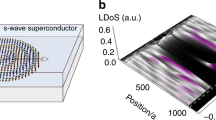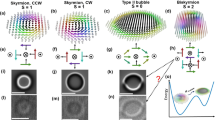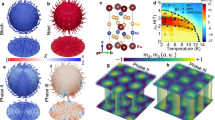Abstract
Topological swirling spin textures, such as skyrmions and merons, have recently attracted much attention as potential building blocks for high-density magnetic information devices. Controlling the transformation between different types of these quasiparticles is an important challenge. To date, these transitions have mostly been limited to a few non-centrosymmetric systems, where they are driven by the Dzyaloshinskii–Moriya interaction. Here we demonstrate multistep topological transitions among a variety of meron and skyrmion crystal states in a centrosymmetric magnet GdRu2Ge2. These are governed by the competition between Ruderman–Kittel–Kasuya–Yosida interactions at inequivalent wave vectors. These findings demonstrate that even a simple centrosymmetric magnet with competing interactions can be a promising material platform to realize a richer variety of magnetic quasiparticles with distinctive symmetry and topology, whose stability can be tuned by various external stimuli.
This is a preview of subscription content, access via your institution
Access options
Access Nature and 54 other Nature Portfolio journals
Get Nature+, our best-value online-access subscription
$29.99 / 30 days
cancel any time
Subscribe to this journal
Receive 12 print issues and online access
$209.00 per year
only $17.42 per issue
Buy this article
- Purchase on Springer Link
- Instant access to full article PDF
Prices may be subject to local taxes which are calculated during checkout




Similar content being viewed by others
Data availability
The data that support the findings of this study are available from the corresponding authors on reasonable request. Source data are provided with this paper.
Code availability
All code used to produce these results is available from the corresponding authors upon reasonable request.
References
Fert, A., Reyren, N. & Cros, V. Magnetic skyrmions: advances in physics and potential applications. Nat. Rev. Mater. 2, 17031 (2017).
Nagaosa, N. & Tokura, Y. Topological properties and dynamics of magnetic skyrmions. Nat. Nanotechnol. 8, 899–911 (2013).
Göbel, B., Mertig, I. & Tretiakov, O. A. Beyond skyrmions: review and perspectives of alternative magnetic quasiparticles. Phys. Rep. 895, 1–28 (2021).
Yu, X. Z. et al. Transformation between meron and skyrmion topological spin textures in a chiral magnet. Nature 564, 95–98 (2018).
Lin, S.-Z. et al. Skyrmion fractionalization and merons in chiral magnets with easy-plane anisotropy. Phys. Rev. B 91, 224407 (2015).
Das, S. et al. Observation of room-temperature polar skyrmions. Nature 568, 368–372 (2019).
Nych, A. et al. Spontaneous formation and dynamics of half-skyrmions in a chiral liquid-crystal film. Nat. Phys. 13, 1215–1220 (2017).
Ackerman, P. J., Boyle, T. & Smalyukh, I. I. Squirming motion of baby skyrmions in nematic fluids. Nat. Comm. 8, 673 (2017).
Tai, J.-S. B. & Smalyukh, I. Three-dimensional crystals of adaptive knots. Science 365, 1449–1453 (2019).
Foster, D. et al. Two-dimensional skyrmion bags in liquid crystals and ferromagnets. Nat. Phys. 15, 655–659 (2019).
Göbel, B. et al. Magnetic bimerons as skyrmion analogues in in-plane magnets. Phys. Rev. B 99, 060407(R) (2019).
Tokura, Y. & Kanazawa, N. Magnetic skyrmion materials. Chem. Rev. 121, 2857–2897 (2021).
Rößler, U. K. et al. Spontaneous skyrmion ground states in magnetic metals. Nature 442, 797–801 (2006).
Mühlbauer, S. et al. Skyrmion lattice in a chiral magnet. Science 323, 915–919 (2009).
Yu, X. Z. et al. Real-space observation of a two-dimensional skyrmion crystal. Nature 465, 901–904 (2010).
Koshibae, W. & Nagaosa, N. Berry curvature and dynamics of a magnetic bubble. New J. Phys. 18, 045007 (2016).
Seki, S., Yu, X. Z., Ishiwata, S. & Tokura, Y. Observation of skyrmions in a multiferroic material. Science 336, 198 (2012).
Tokunaga, Y. et al. A new class of chiral materials hosting magnetic skyrmions beyond room temperature. Nat. Commun. 6, 7638 (2015).
Nayak, A. K. et al. Magnetic antiskyrmions above room temperature in tetragonal Heusler materials. Nature 548, 561–566 (2017).
Karube, K. et al. Room-temperature antiskyrmions and sawtooth surface textures in a non-centrosymmetric magnet with S4 symmetry. Nat. Mater. 20, 335–340 (2021).
Hayami, S., Ozawa, R. & Motome, Y. Effective bilinear-biquadratic model for noncoplanar ordering in itinerant magnets. Phys. Rev. B 95, 224424 (2017).
Hayami, S. & Motome, Y. Square skyrmion crystal in centrosymmetric itinerant magnets. Phys. Rev. B 103, 024439 (2021).
Martin, I. & Batista, C. D. Itinerant electron-driven chiral magnetic ordering and spontaneous quantum Hall effect in triangular lattice models. Phys. Rev. Lett. 101, 156402 (2008).
Okubo, T. et al. Multiple-q states and the skyrmion lattice of the triangular-lattice Heisenberg antiferromagnet under magnetic fields. Phys. Rev. Lett. 108, 017206 (2012).
Leonov, A. O. & Mostovoy, M. Multiply periodic states and isolated skyrmions in an anisotropic frustrated magnet. Nat. Commun. 6, 8275 (2015).
Wang, Z. et al. Meron, skyrmion, and vortex crystals in centrosymmetric tetragonal magnets. Phys. Rev. B 103, 104408 (2021).
Bouaziz, J. et al. Fermi-surface origin of skyrmion lattices in centrosymmetric rare-earth intermetallics. Phys. Rev. Lett. 128, 157206 (2022).
Kurumaji, T. et al. Skyrmion lattice with a giant topological Hall effect in a frustrated triangular-lattice magnet. Science 365, 914–918 (2019).
Khanh, N. D. et al. Nanometric square skyrmion lattice in a centrosymmetric tetragonal magnet. Nat. Nanotechnol. 15, 444–449 (2020).
Hirschberger, M. et al. Skyrmion phase and competing magnetic orders on a breathing kagomé lattice. Nat. Commun. 10, 5831 (2019).
Kaneko, K. et al. Unique helical magnetic order and field-induced phase in trillium lattice antiferromagnet EuPtSi. J. Phys. Soc. Jpn 88, 13702 (2019).
Yasui, Y. et al. Imaging the coupling between itinerant electrons and localised moments in the centrosymmetric skyrmion magnet GdRu2Si2. Nat. Commun. 11, 5925 (2020).
Khanh, N. D. et al. Zoology of multiple-Q spin textures in a centrosymmetric tetragonal magnet with itinerant electrons. Adv. Sci. 9, 2105452 (2022).
Takagi, R. et al. Square and rhombic lattices of magnetic skyrmions in a centrosymmetric binary compound. Nat. Commun. 13, 1472 (2022).
Li, Z. et al. Discovery of topological magnetic textures near room temperature in quantum magnet TbMn6Sn6. Adv. Mater. 35, 2211164 (2023).
Garnier, A., Gignoux, D., Schmitt, D. & Shigeoka, T. Giant magnetic anisotropy in tetragonal GdRu2Ge2 and GdRu2Si2. Phys. B 222, 80–86 (1996).
Neubauer, A. et al. Topological Hall effect in the A phase of MnSi. Phys. Rev. Lett. 102, 186602 (2009).
Nagaosa, N. et al. Anomalous Hall effect. Rev. Mod. Phys. 82, 1539 (2010).
Zadorozhnyi, A. & Dahnovsky, Y. Topological Hall effect in three-dimensional centrosymmetric magnetic skyrmion crystals. Phys. Rev. B 107, 054436 (2023).
Adams, T. et al. Long-range crystalline nature of the skyrmion lattice in MnSi. Phys. Rev. Lett. 107, 217206 (2011).
Blume, M. in Resonant Anomalous X-Ray Scattering (eds Materlik, G. et al.) 495–512 (Elsevier, 1994).
Hayami, S. Multiple skyrmion crystal phases by itinerant frustration in centrosymmetric tetragonal magnets. J. Phys. Soc. Jpn 91, 023705 (2022).
Peng, L. et al. Controlled transformation of skyrmions and antiskyrmions in a non-centrosymmetric magnet. Nat. Nanotechnol. 15, 181–186 (2020).
Jena, J. et al. Observation of fractional spin textures in a Heusler material. Nat. Commun. 11, 1115 (2020).
Zheng, F. et al. Experimental observation of chiral magnetic bobbers in B20-type FeGe. Nat. Nanotechnol. 13, 451–455 (2018).
Oike, H. et al. Interplay between topological and thermodynamic stability in a metastable magnetic skyrmion lattice. Nat. Phys. 12, 62–66 (2016).
Itoh, S. et al. High Resolution Chopper Spectrometer (HRC) at J-PARC. Nucl. Instrum. Methods Phys. Res. A 631, 90–97 (2011).
Azuah, R. T. et al. DAVE: a comprehensive software suite for the reduction, visualization, and analysis of low energy neutron spectroscopic data. J. Res. Natl Inst. Stand. Technol. 114, 341–358 (2009).
Momma, K. & Izumi, F. VESTA 3 for three-dimensional visualization of crystal, volumetric and morphology data. J. Appl. Crystallogr. 44, 1272–1276 (2011).
Acknowledgements
We thank Y. Motome, A. Kikkawa, X. Z. Yu, N. Shibata, T. Seki and S. Toyama for enlightening discussions and experimental helps. This work was partly supported by Grants-In-Aid for Scientific Research (grant nos 18H03685, 20H00349, 21H04440, 21H04990, 21K13876, 21K18595, 22H04965, 22H04468, 22KJ1061, 23K13069 and 23H04869) from JSPS, PRESTO (grant nos JPMJPR18L5, JPMJPR20B4, JPMJPR20L8) and CREST (grant no. JPMJCR1874, JPMJCR23O4) from JST, Katsu Research Encouragement Award and UTEC-UTokyo FSI Research Grant Program of the University of Tokyo, Asahi Glass Foundation and Murata Science Foundation. This work is based on experiments performed at Materials and Life Science Experimental Facility (MLF) in the Japan Proton Accelerator Research Complex (J-PARC) (Proposal No. 2020S01) and Photon Factory in High Energy Accelerator Research Organization (Proposal No. 2020G665). The illustration of crystal structure was drawn by VESTA49.
Author information
Authors and Affiliations
Contributions
S.S. and R.T. conceived the project. H.Y. and R.T. grew single crystals and characterized the magnetic and transport properties with the assistance of S.S., N.D.K. and Y.T. RXS measurements were carried out by H.Y., R.T., J.J. and T.N. with the assistance of H. Saito, H. Sagayama, H.N. and T.A. Neutron scattering measurements were carried out by J.J., H. Saito., S.I. and T.N. Theoretical simulation was performed by S.H. The manuscript was written by H.Y. and S.S. with the assistance of S.H. and T.N. All the authors discussed the results and commented on the manuscript.
Corresponding authors
Ethics declarations
Competing interests
The authors declare no competing interests.
Peer review
Peer review information
Nature Physics thanks Sujit Das, Jonathan White and the other, anonymous, reviewer(s) for their contribution to the peer review of this work.
Additional information
Publisher’s note Springer Nature remains neutral with regard to jurisdictional claims in published maps and institutional affiliations.
Supplementary information
Supplementary Information
Supplementary Figs. 1–14, Notes 1–12 and Table 1.
Source data
Source Data Fig. 1
Statistical source data.
Source Data Fig. 2
Statistical source data.
Source Data Fig. 4
Statistical source data.
Rights and permissions
Springer Nature or its licensor (e.g. a society or other partner) holds exclusive rights to this article under a publishing agreement with the author(s) or other rightsholder(s); author self-archiving of the accepted manuscript version of this article is solely governed by the terms of such publishing agreement and applicable law.
About this article
Cite this article
Yoshimochi, H., Takagi, R., Ju, J. et al. Multistep topological transitions among meron and skyrmion crystals in a centrosymmetric magnet. Nat. Phys. (2024). https://doi.org/10.1038/s41567-024-02445-9
Received:
Accepted:
Published:
DOI: https://doi.org/10.1038/s41567-024-02445-9



